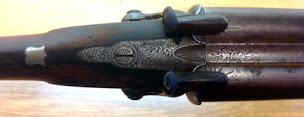It's a new month and we are still in lockdown - but there seems to be light at the end of the tunnel [ just hoping it's not a train coming!!!]. I have had my first jab, the daffodils are about to flower, the bees have been flying and there are plans for a Howden Show this year - so fingers crossed.
Local history queries still come into the website - some people want transcriptions of old documents carrying out, others are after old photos or just background information. One lady wanted a picture of local man Billie Glew who was shot down in 1918 only days before the end of the war. He was only 18.
But I was recently asked if I knew anything about a Howden gunsmith called William Wood. The gentleman asking had a gun made by him but wondered about where he lived and when he was working. So, as it is still not really gardening weather I had a look at who he was and it was an interesting story.
William Wood, gunmaker of Howden
The earliest I can find the Wood family in Howden is the 1830s. John Wood was a whitesmith, originally from Pontefract and he and his family lived in the Market Place where the Shire hall is now.
The Woods lived in the right had end of the very old building, next to Mr Woodall, auctioneer on this early picture which dates from around 1870. Next door to them was a shoemaker, Mr Pease who also kept a temperance hotel.
In 1851 John and his wife Hannah were living there with their adult children Ann and William while another son John was an apprentice with a wine merchant.
William Wood was born in Howden in 1832 and was apprenticed to his father as a whitesmith.
William married local girl Mary Ann Hawke in 1860 and the young couple moved into the Market Place premises. William for the first time was described as a gunsmith – and bell hanger. His parents had moved out to a house in Hailgate.
There is a newspaper report of a near disaster which took place in March 1861. It reads as follows
23rd March 1861
On Wednesday last, a fire broke the dwelling-house of Mr. Wm. Wood, gunsmith and bell-hanger, in the Market-place, which used great consternation, in consequence of its being that large quantity of gunpowder was stored in the premises. It was discovered between ten and eleven o'clock in the forenoon by neighbour, who observed smoke issuing from a back chamber window, and entering the house, the sleeping-room of the house was found be in flames. An outcry of fire and the ringing of the fire-bell, speedily brought a considerable number of neighbours, who supplied buckets, which were filled from the Market-place pump, and from another pump in the yard. The buckets were then passed from hand to hand, and the water very judiciously applied. The fire was completely extinguished the arrival of the engine. The house forms a portion of a very ancient timber building, occupying a considerable part of one side of the Market Place. If the fire had spread beyond the bed-room, it is probable that it would have been beyond the power of one engine to subdue it, and the destruction to property would no doubt have been serious, independent of the awful effects of the gunpowder, which could scarcely have been removed if the fire had spread rapidly. Fortunately, the floor above the bedroom was of plaster, which, under Providence, was the means of preserving us from great calamity. The cause of the fire is not known. It is supposed have been smouldering for some time in the straw mattress, which may have been ignited by a match accidentally placed beneath it, or from a lighted match carelessly thrown away by the servant-girl.
William and Mary Ann had three children, Annie, Charles and Edith. But sadly Mary Ann died aged 33 in 1867.
The family then moved out of the Market Place property which they had rented from Mrs Mary Dunn. In 1870 Mrs Dunn sold it to the Howden Market Hall company. The then occupiers James Pheasant, a tailor and Thomas Hill, a butcher had to move out.
In June 1871 the ancient building was demolished to make way for the new market hall, which we now know as the Shire hall.
Meanwhile the Wood families, had moved to Bridgegate, to the Angel Inn, where presumably Mrs Wood could help widower William look after the children. The Angel stood on the present site of the bathroom shop.
But William’s mother died in June 1870 and in April 1871 John Wood was described as a licensed victualler running the Angel Inn. And living there too was William Wood, aged 39, a gunsmith and the children Annie, Charles and Edith.
 |
| The gun is inscribed Wm Wood Howden |
But this is the last time William describes himself as a gunsmith. In 1881 he and his family are living next to the Wellington, possibly where there is now a flower shop. William is then described as an ironmonger. His father, who was living with him, died in 1885.
His widow, Ada, married again and had two children, Cyril and Ethel with her second husband, William White.
William in 1901 was living in Campbell Terrace on Northolmby St, retired ironmonger with Gertrude, his grand daughter age 15.
He died in 1906.
I have searched for other Howden gunmakers and have not found any other references to one. Or to any other guns by William Wood so it is great that this one has survived.


